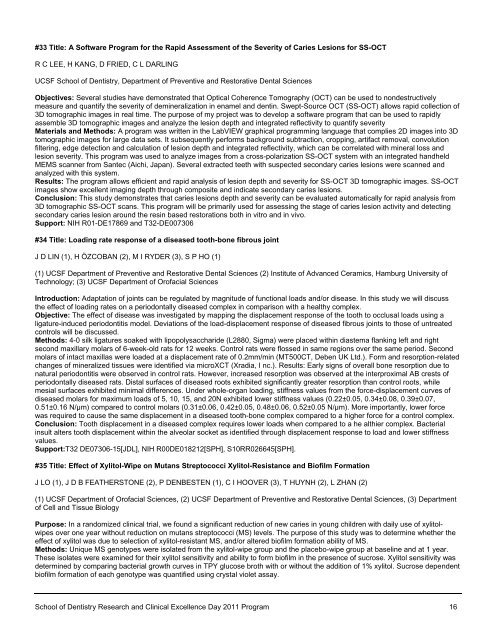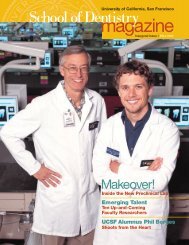Acknowledgements - UCSF School of Dentistry - University of ...
Acknowledgements - UCSF School of Dentistry - University of ...
Acknowledgements - UCSF School of Dentistry - University of ...
Create successful ePaper yourself
Turn your PDF publications into a flip-book with our unique Google optimized e-Paper software.
#33 Title: A S<strong>of</strong>tware Program for the Rapid Assessment <strong>of</strong> the Severity <strong>of</strong> Caries Lesions for SS-OCT<br />
R C LEE, H KANG, D FRIED, C L DARLING<br />
<strong>UCSF</strong> <strong>School</strong> <strong>of</strong> <strong>Dentistry</strong>, Department <strong>of</strong> Preventive and Restorative Dental Sciences<br />
Objectives: Several studies have demonstrated that Optical Coherence Tomography (OCT) can be used to nondestructively<br />
measure and quantify the severity <strong>of</strong> demineralization in enamel and dentin. Swept-Source OCT (SS-OCT) allows rapid collection <strong>of</strong><br />
3D tomographic images in real time. The purpose <strong>of</strong> my project was to develop a s<strong>of</strong>tware program that can be used to rapidly<br />
assemble 3D tomographic images and analyze the lesion depth and integrated reflectivity to quantify severity<br />
Materials and Methods: A program was written in the LabVIEW graphical programming language that complies 2D images into 3D<br />
tomographic images for large data sets. It subsequently performs background subtraction, cropping, artifact removal, convolution<br />
filtering, edge detection and calculation <strong>of</strong> lesion depth and integrated reflectivity, which can be correlated with mineral loss and<br />
lesion severity. This program was used to analyze images from a cross-polarization SS-OCT system with an integrated handheld<br />
MEMS scanner from Santec (Aichi, Japan). Several extracted teeth with suspected secondary caries lesions were scanned and<br />
analyzed with this system.<br />
Results: The program allows efficient and rapid analysis <strong>of</strong> lesion depth and severity for SS-OCT 3D tomographic images. SS-OCT<br />
images show excellent imaging depth through composite and indicate secondary caries lesions.<br />
Conclusion: This study demonstrates that caries lesions depth and severity can be evaluated automatically for rapid analysis from<br />
3D tomographic SS-OCT scans. This program will be primarily used for assessing the stage <strong>of</strong> caries lesion activity and detecting<br />
secondary caries lesion around the resin based restorations both in vitro and in vivo.<br />
Support: NIH R01-DE17869 and T32-DE007306<br />
#34 Title: Loading rate response <strong>of</strong> a diseased tooth-bone fibrous joint<br />
J D LIN (1), H ÖZCOBAN (2), M I RYDER (3), S P HO (1)<br />
(1) <strong>UCSF</strong> Department <strong>of</strong> Preventive and Restorative Dental Sciences (2) Institute <strong>of</strong> Advanced Ceramics, Hamburg <strong>University</strong> <strong>of</strong><br />
Technology; (3) <strong>UCSF</strong> Department <strong>of</strong> Or<strong>of</strong>acial Sciences<br />
Introduction: Adaptation <strong>of</strong> joints can be regulated by magnitude <strong>of</strong> functional loads and/or disease. In this study we will discuss<br />
the effect <strong>of</strong> loading rates on a periodontally diseased complex in comparison with a healthy complex.<br />
Objective: The effect <strong>of</strong> disease was investigated by mapping the displacement response <strong>of</strong> the tooth to occlusal loads using a<br />
ligature-induced periodontitis model. Deviations <strong>of</strong> the load-displacement response <strong>of</strong> diseased fibrous joints to those <strong>of</strong> untreated<br />
controls will be discussed.<br />
Methods: 4-0 silk ligatures soaked with lipopolysaccharide (L2880, Sigma) were placed within diastema flanking left and right<br />
second maxillary molars <strong>of</strong> 6-week-old rats for 12 weeks. Control rats were flossed in same regions over the same period. Second<br />
molars <strong>of</strong> intact maxillas were loaded at a displacement rate <strong>of</strong> 0.2mm/min (MT500CT, Deben UK Ltd.). Form and resorption-related<br />
changes <strong>of</strong> mineralized tissues were identified via microXCT (Xradia, I nc.). Results: Early signs <strong>of</strong> overall bone resorption due to<br />
natural periodontitis were observed in control rats. However, increased resorption was observed at the interproximal AB crests <strong>of</strong><br />
periodontally diseased rats. Distal surfaces <strong>of</strong> diseased roots exhibited significantly greater resorption than control roots, while<br />
mesial surfaces exhibited minimal differences. Under whole-organ loading, stiffness values from the force-displacement curves <strong>of</strong><br />
diseased molars for maximum loads <strong>of</strong> 5, 10, 15, and 20N exhibited lower stiffness values (0.22±0.05, 0.34±0.08, 0.39±0.07,<br />
0.51±0.16 N/µm) compared to control molars (0.31±0.06, 0.42±0.05, 0.48±0.06, 0.52±0.05 N/µm). More importantly, lower force<br />
was required to cause the same displacement in a diseased tooth-bone complex compared to a higher force for a control complex.<br />
Conclusion: Tooth displacement in a diseased complex requires lower loads when compared to a he althier complex. Bacterial<br />
insult alters tooth displacement within the alveolar socket as identified through displacement response to load and lower stiffness<br />
values.<br />
Support:T32 DE07306-15[JDL], NIH R00DE018212[SPH], S10RR026645[SPH].<br />
#35 Title: Effect <strong>of</strong> Xylitol-Wipe on Mutans Streptococci Xylitol-Resistance and Bi<strong>of</strong>ilm Formation<br />
J LO (1), J D B FEATHERSTONE (2), P DENBESTEN (1), C I HOOVER (3), T HUYNH (2), L ZHAN (2)<br />
(1) <strong>UCSF</strong> Department <strong>of</strong> Or<strong>of</strong>acial Sciences, (2) <strong>UCSF</strong> Department <strong>of</strong> Preventive and Restorative Dental Sciences, (3) Department<br />
<strong>of</strong> Cell and Tissue Biology<br />
Purpose: In a randomized clinical trial, we found a significant reduction <strong>of</strong> new caries in young children with daily use <strong>of</strong> xylitolwipes<br />
over one year without reduction on mutans streptococci (MS) levels. The purpose <strong>of</strong> this study was to determine whether the<br />
effect <strong>of</strong> xylitol was due to selection <strong>of</strong> xylitol-resistant MS, and/or altered bi<strong>of</strong>ilm formation ability <strong>of</strong> MS.<br />
Methods: Unique MS genotypes were isolated from the xylitol-wipe group and the placebo-wipe group at baseline and at 1 year.<br />
These isolates were examined for their xylitol sensitivity and ability to form bi<strong>of</strong>ilm in the presence <strong>of</strong> sucrose. Xylitol sensitivity was<br />
determined by comparing bacterial growth curves in TPY glucose broth with or without the addition <strong>of</strong> 1% xylitol. Sucrose dependent<br />
bi<strong>of</strong>ilm formation <strong>of</strong> each genotype was quantified using crystal violet assay.<br />
<strong>School</strong> <strong>of</strong> <strong>Dentistry</strong> Research and Clinical Excellence Day 2011 Program 16




